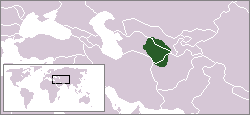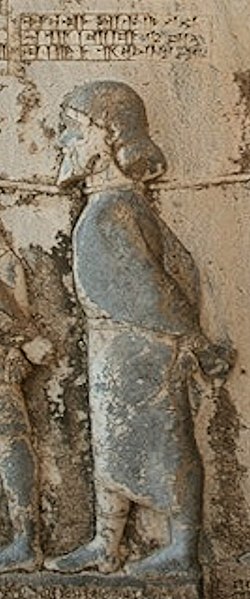
| MARGIANA
Margiana, ca. 300 BC Margiana
/ Marv :
Margiana (Greek: Margiane, Old Persian: Marguš, Middle Persian: Marv) is a historical region centred on the oasis of Merv and was a minor satrapy within the Achaemenid satrapy of Bactria, and a province within its successors, the Seleucid, Parthian and Sasanian empires.
It was located in the valley of the Murghab River which has its sources in the mountains of Afghanistan, and passes through Murghab District in modern Afghanistan, and then reaches the oasis of Merv in modern Turkmenistan. Margiana bordered Parthia to the south-west, Aria in the south, Bactria in the east and Sogdia in the north.
History
:
Achaemenid period :
Behistun relief of Frâda, a king of Margiana circa 522 BC. Label: "This is Frâda. He lied, saying "I am king of Margiana."" Margiana was conquered by the Persian king Cyrus the Great between 545 and 539 BC and remained as part of the satrapy of Bactria. Cyrus also founded the city of Merv. After Darius the Great's victory over the Magian usurper, Gaumata, in September 522 BC, revolts spread throughout the empire. The revolt in Margiana, led by a certain Frâda (Phraates), was suppressed almost immediately, in December 521 BC by Dadarsi, the Satrap of Bactria. In the Aramaic version of the Behistun Inscription, it is claimed that 55,423 Margians were killed and 6,972 taken captive in the aftermath of the revolt. Margiana was separated from the satrapy of Bactria and joined to the satrapy of Aria at some point after the rule of Darius the Great.
Following the Battle of Gaugamela in 331 BC, in which Alexander the Great defeated Darius III, Darius III began his retreat to Bactria, however he was overthrown by the Satrap of Bactria, Bessus, who continued the retreat eastward through Aria and Margiana. Bessus, who had expected an attack from Alexander along the Silk Road, was surprised when Alexander had advanced through Gedrosia and Arachosia and crossed the Hindu Kush mountains in 329 BC to invade Bactria. Bessus fled north to Sogdia where he too was betrayed and was handed over to Alexander by his courtiers, Spitamenes and Datames.
In July 329 BC, as Alexander founded the city of Alexandria Eschate on the northern border of Sogdia, Spitamenes led a revolt and besieged the Sogdian capital of Maracanda. A Scythian incursion into Sogdia prevented Alexander from responding personally, however, once he had defeated the Scythians in the Battle of Jaxartes, he marched south to relieve Maracanda causing Spitamenes to move south and attack Balkh in the winter of 329 BC. In the spring of 328 BC, Alexander sent his general Craterus to fortify Margiana, where he established a garrison in Merv and re-founded the city as Alexandria in Margiana. Alexander's general Coenus defeated Spitamenes in the Battle of Gabai in December 328 BC, and subsequently in the following year Sogdia was merged with Bactria to form a single satrapy under the rule of Philip.
Hellenistic
Period :
Margiana was conquered by the Parthians under Mithridates I of Parthia in c. 170 BC. The defeat of the Yuezhi people in 175 BC caused many Yuezhi to flee westwards, displacing the Saka as a result, leading to a mass movement of Saka and Yuezhi towards Sogdia and Bactria. Around 140 BC the Saka invaded Parthian territory through Margiana, venturing as far as Media in central Iran and continued to harass the Parthians until 124 BC, during which they defeated and killed two successive Parthian kings. The Yuezhi, who had settled in Sogdia along the Oxus, controlled Margiana until 115 BC when Mithridates II of Parthia re-established control over the east, forcing the Yuezhi to move south into Bactria. In 53 BC, 10,000 Roman prisoners captured by the Parthians after the Battle of Carrhae in Upper Mesopotamia were settled in Antiochia in Margiana. The Yuezhi went on to conquer the remaining Greek territories in Paropamisadae and establish the Kushan Empire.
Post-Hellenistic
period :
In 642 AD, after the Sasanian disaster at the hands of the Rashidun Caliphate at the Battle of Nihawand, much like Darius III, the last Sasanian king, Yazdegerd III, fled eastward and arrived in Margiana in 651 AD. Yazdegerd was well received by Mahoe Suri, the marzban of Merv, however, upon arrival Yazdegerd appointed his courtier Farrukhzad as marzban and ordered that Mahoe give absolute control of the city over to him. Mahoe refused and Farrukhzad advised the king to retreat to Tabaristan, which he ignored. Farrukhzad then left for Tabaristan, where he would later become king himself. As the Muslim army approached, Mahoe plotted with the Hepthalite ruler Nezak Tarkan to overthrow Yazdegerd who later discovered the plot and retreated to Marwir-Rawdh in southern Margiana. Mahoe agreed to pay tribute to the Rashidun general Ahnaf ibn Qais who began to consolidate Islam in Margiana and awaited reinforcements. Ahnaf captured Merw i-Rud, forcing Yazdegerd to flee to Balkh with his remaining supporters. Ahnaf was ordered by the Caliph Umar ibn al-Khattab to remain at Merv and not pursue Yazdegerd. However, upon learning that Yazdegerd had formed an alliance with Hepthalites beyond Margiana and was approaching Merv, Ahnaf rallied his forces and defeated Yazdegerd at the Battle of Oxus River. After his defeat, the Sasanian king attempted to hide in a mill where he was killed by a Margian miller, bringing the Sasanian Empire to an end.
Religion
:
According to Al-Biruni, Christianity had spread to Margiana within 200 years of the birth of Christ. In the 3rd century AD, at least one Christian monastery was founded and a reference to a diocese based in Merv is first mentioned in 334. A Nestorian diocese, based in the city of Merv, is known to have existed from 424 AD,and it later became a metropolitan province in 554. The uncommon name of the first recorded bishop of Merv, Bar Shaba, which means "son of the deportation", would suggest that the Christian community in Margiana may have been deported from Roman territory. A diocese of Merw i-Rud in southern Margiana also existed in 554.
Source :
https://en.wikipedia.org/ |

